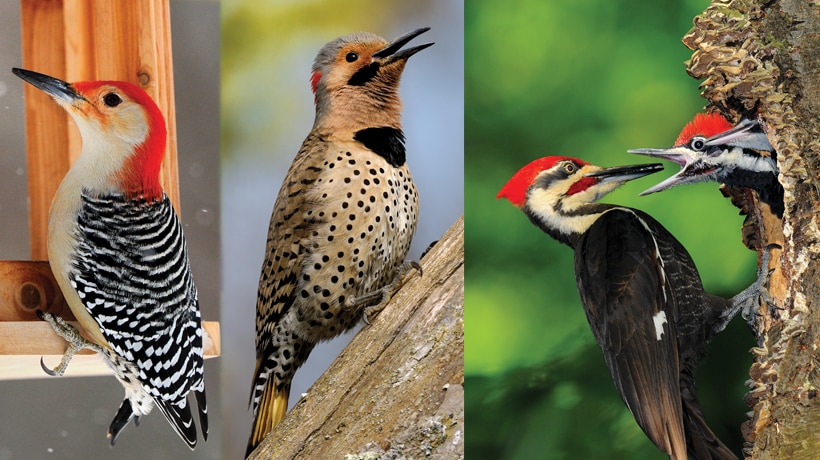Encountering Woodpeckers in Florida Variety: Environments and Habits
Encountering Woodpeckers in Florida Variety: Environments and Habits
Blog Article
Unveiling the Keys of Woodpeckers: Behavior, Habitat, and Extra
Woodpeckers, with their special habits and specialized adaptations, have long amazed scientists and nature enthusiasts alike. By uncovering the mysteries bordering woodpeckers' actions and environment options, a deeper understanding of these avian wonders arises, supplying a glance right into their interesting world.
Woodpecker Behavior Insights
In examining woodpecker actions, a remarkable display screen of specialized skills and adaptations arises, clarifying their exceptional environmental niche - Woodpeckers in Florida. Woodpeckers, recognized for their unique drumming on trees, possess a variety of behavior qualities that contribute to their survival and success in their environment. One vital habits is their drumming, which serves numerous functions such as communication, establishing region, bring in mates, and situating food resources. This rhythmic pecking additionally showcases their exceptional strength and endurance, as they can hammer away continually at broadband without creating damage to themselves.
Furthermore, woodpeckers show an unique feeding habits characterized by their capability to remove bugs from tree bark utilizing their specialized beaks. Their long, barbed tongues help in recording prey, while their solid neck muscular tissues offer security and precision during pecking activities. This feeding strategy enables woodpeckers to accessibility covert insect larvae and remove them with impressive efficiency.
Habitat Preferences and Option
What elements affect the environment preferences and selection of woodpeckers? Woodpeckers are extremely versatile birds known to occupy numerous settings worldwide. However, they do display choices for certain habitat qualities. One vital factor influencing woodpecker habitat choice is the accessibility of ideal nesting websites. Woodpeckers typically choose forests with a mix of mature trees that supply adequate possibilities for dental caries excavation. These dental caries act as crucial nesting and roosting sites for woodpeckers and are important for their breeding success.
In addition, woodpeckers show a preference for environments with a plentiful supply of food sources. They are primarily insectivorous, feeding on beetles, ants, larvae, and various other pests located in rotting wood or tree bark. Woodpeckers often tend to favor wooded locations with a diverse insect population to fulfill their dietary needs.
In addition, the visibility of dead or rotting trees is another vital aspect in woodpecker habitat option. These trees not only provide food resources however also use appropriate substratum for tooth cavity excavation. Dead trees are important for the upkeep of healthy woodpecker populations, as they play a crucial role in the woodpeckers' life process and community characteristics.
Feeding Practices and Diet Structure
Woodpeckers demonstrate a specialized feeding actions concentrated on foraging for insects within different environments. In addition to insects, woodpeckers likewise eat tree sap, fruits, nuts, and seeds, adding range to their diet plan depending on the period and websites availability of food sources.
The foraging techniques of woodpeckers are well-adapted to their arboreal lifestyle. Woodpeckers play a crucial duty in preserving the health and wellness of forests by regulating insect populaces and aiding in the decomposition of timber.
Drumming Seems and Communication
Utilizing quick drumming noises on various surface areas, woodpeckers utilize a distinctive kind of interaction to signal region limits and attract friends. This drumming habits is not only a method of communication but additionally acts as a way for woodpeckers to develop their existence within a particular location. The intensity, rate, and pattern of the drumming can convey vital info to other woodpeckers around.
Woodpeckers use drumming audios to reveal their visibility in an area and to warn off prospective intruders. The loud and recurring nature of the drumming functions as a Full Report clear signal to various other woodpeckers that the area is currently asserted. This assists in reducing disputes and minimizing physical fights between individuals.

Survival Adaptations and Specialized Makeup

Final Thought
In final thought, woodpeckers exhibit unique actions, such as drumming noises for communication, and have actually specialized composition for survival in their selected habitats. Their feeding behaviors and diet plan composition better show their adaptability to numerous atmospheres. By understanding these facets of woodpeckers, scientists and conservationists can much better secure and preserve these remarkable birds and their communities.
Report this page